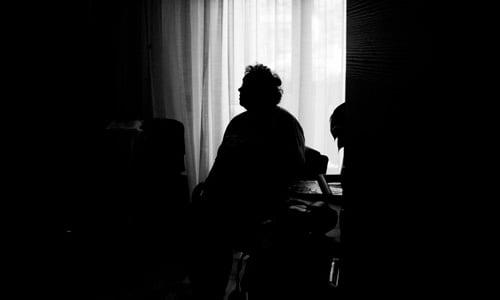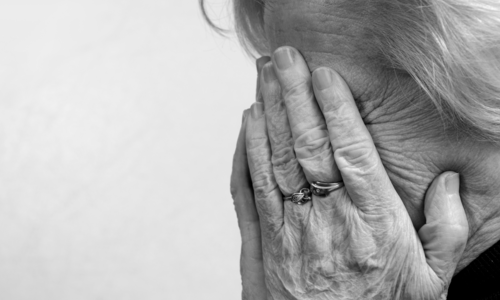People tend to think of victim-survivors of domestic abuse as young women, often with young children. However, at Age UK we know that there are gaps in the data, which reinforce the myth of a ‘typical’ victim-survivor.
Domestic abuse can happen to anyone, and victim-survivors – and perpetrators – of domestic abuse are adults of all ages. Being older doesn't protect people from abuse, and some older people have been subjected to abuse for decades.
That’s why we were so relieved when, in 2020, the Office for National Statistics agreed with us that there should be no upper age limit on who they asked about domestic abuse and started asking women and men of all ages whether they had been subjected to domestic abuse in their Crime Survey for England and Wales. Previously they had only asked people who were aged up to 74, so there was a shortage of good data on the domestic abuse of people aged 75 and older.
At the beginning of this year’s 16 Days of Activism Against Gender-Based Violence, the ONS published the first data on victims of domestic abuse of all ages. Sadly, this data shows that 1 in 30 people aged 60 to 74 and approximately 1 in 50 people aged 75+ have been subjected to domestic abuse in the past year. That means more than 400,000 older people have been victims of domestic abuse in the past year in England and Wales alone.
At Age UK we are hearing from increasing numbers of older people telling us they are being subjected to domestic abuse. So now, as the 16 Days of Activism draws to a close, we want to take the opportunity to highlight the experiences of older victim-survivors of domestic abuse.
Domestic abuse and older people
Like younger people, older people may be subjected to domestic abuse that is physical, sexual, emotional, or economic. Perpetrators will use a range of behaviours to exert power and control. But there are also some important age-related differences that specifically affect victim-survivors as they age.
For example, older people are just as likely to be abused by an adult child or grandchild as they are a spouse or partner – this also means that men become at increased risk of being subjected to domestic abuse as they age. Many older people subjected to abuse have a health condition or disability, which may mean they rely on their abuser for care and support.
Older people may face several barriers to seeking and accessing support. This can be due to a range of factors, including a lack of awareness among health and social care professionals. Tools used by professionals to assess risk of domestic abuse are often aimed at younger women and intimate partner abuse, and don’t consider the specific risk factors affecting older people and the wider range of potential perpetrators.
Older people with disabilities, or those from LGBTQ+ and ethnic minority backgrounds, may face further barriers to leaving an abusive relationship – this may be due to a lack of appropriate services, community barriers, discrimination, or a reliance on carers. And the cost of living crisis may leave older people more isolated and make it more difficult to leave where they share a home or rely financially on their abuser. Finally, older people themselves may feel shame, wish to protect their family members, or the abuse they are subjected to may have become so normalised that it is difficult to recognise.
What more can be done?
The stereotype of a typical victim-survivor as a younger woman means that opportunities to identify and respond to older people experiencing domestic abuse are often missed. We need to raise awareness among health and social care professionals working with older people and ensure that they feel confident in spotting the signs of domestic abuse in those they work with. We want health and social care professionals to take opportunities to ask about possible domestic abuse at hospital discharge, care assessments or GP appointments, and direct older people to appropriate support where this is wanted and needed.
We also need better data about older people and domestic abuse. The new ONS data is a step in the right direction, but we need to make sure that data collected locally accurately records domestic abuse among older people where this has occurred.
Finally, more resources should be made available to meet the needs of older victims and survivors.
What is Age UK doing?
Age UK is partnering with Hourglass, the charity working to end the abuse and neglect of older people. Complex abuse cases received by Age UK’s Safeguarding team will be discussed with the older victim in question and, with their permission, referred to a specialist Hourglass team made up of case workers, community response network and IDVAs (Independent Domestic Violence Advocates). Hourglass will then help build tailored safety plans and support older people to rebuild their confidence and recover.
Age UK has also joined Employers Initiative on Domestic Abuse (EIDA), a network of employers committed to supporting their employees who are or have been subjected to domestic abuse. At Age UK we have created a culture where employees are able to access domestic abuse awareness training, specialist information, and use their work equipment to empower them to find support safely. If our employees have increased awareness, this will enable them to recognise the signs and support the older people Age UK is here for.
Our safeguarding team’s domestic abuse specialist speaks at conferences and events, amplifying the voices of older victim-survivors of domestic abuse. This work educates professionals who work with older people to recognise the subtle signs that an older person may be subjected to domestic abuse and empowers them to confidently reach in and ask appropriate, sensitive questions.
Understanding domestic abuse
Domestic abuse can take many forms. Age UK has information about how domestic abuse can look and feel, and advice about the support available.





